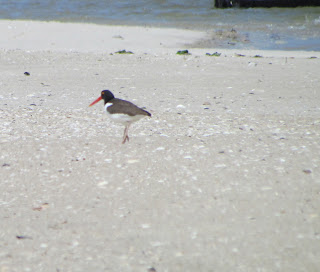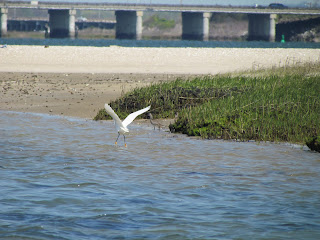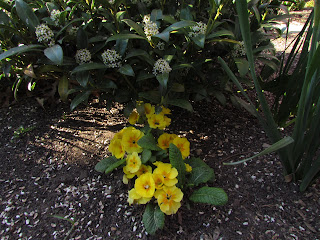Last week I read about a program for would-be poets scheduled at the Nature Center at Jones Beach State Park on Saturday. While interested, I didn't think about attending until I received a second notice from a friend via email describing the workshop. Fate was calling. I took the plunge and went alone, stepping outside my comfort zone a bit, since I almost always travel with a friend or with the Admiral.
It was a workshop made in heaven for me. I love walking the deserted reaches of Long Island's barrier beaches, stopping often to meditate on the flora and fauna of this seemingly desolate landscape. Salt water flows in my veins and for as long as I can recall, memories take me near the shore. Since I've been trying for a few years to write poetry and am at the point where I need some critiquing from poets further along in writing, it was perfect.
First a naturalist took seven of us out along the bay side near the Theodore Roosevelt Nature Center, formerly West End 1. In my youth, I worked at this field as a cashier, meeting lots of cute high school boys from Wantagh and earning money for nursing school. In those days I didn't notice the flowering beach plums or the oyster catchers along the shore, although I do remember that the horseshoe crabs impressed me even then.
The shore birds were plentiful, as always, and invited picture snapping, since I can see the birds better through my camera lens than I can with binoculars.
The poet, Maxwell C. Wheat, Jr. Nassau County's first poet laureate, instructed us to take notes as we walked, observe the surroundings using all of our senses, ask questions of the naturalist and soak up ideas with the intent of eventually creating a poem.
We returned to the classroom after traipsing the beach for an hour or so and our poet coaxed us to attempt a list poem about the morning's walk. I had lots of images in my notebook, the barest beginnings of a poem. The other poets, more experienced than this would-be bard, read what they had produced in a mere twenty minutes. I was impressed.
I needed a day or two to let my experience percolate in my sub-conscious and I now have a rough draft to continue working on , perhaps this week.
Beach Bard
Take-Away for Today - Stepping out of my usual routine felt good, and I wrote a poem!
It was a workshop made in heaven for me. I love walking the deserted reaches of Long Island's barrier beaches, stopping often to meditate on the flora and fauna of this seemingly desolate landscape. Salt water flows in my veins and for as long as I can recall, memories take me near the shore. Since I've been trying for a few years to write poetry and am at the point where I need some critiquing from poets further along in writing, it was perfect.
 |
| Beach Plums in flower |
 |
| Against the brilliant sky |
 |
| Oyster Catcher faces the wind |
 |
| Horse shoe crab reacts to being returned to the bay |
 |
| Rescued pair of Horseshoe Crabs |
 |
| A Snowy Egret takes off as a Willet watches |
 |
| A pair of Common Terns |
The shore birds were plentiful, as always, and invited picture snapping, since I can see the birds better through my camera lens than I can with binoculars.
The poet, Maxwell C. Wheat, Jr. Nassau County's first poet laureate, instructed us to take notes as we walked, observe the surroundings using all of our senses, ask questions of the naturalist and soak up ideas with the intent of eventually creating a poem.
We returned to the classroom after traipsing the beach for an hour or so and our poet coaxed us to attempt a list poem about the morning's walk. I had lots of images in my notebook, the barest beginnings of a poem. The other poets, more experienced than this would-be bard, read what they had produced in a mere twenty minutes. I was impressed.
I needed a day or two to let my experience percolate in my sub-conscious and I now have a rough draft to continue working on , perhaps this week.
Beach Bard
The bay whispers an old tale,
Cadenced with the whining wind,
Couplets in a briny yarn.
Couplets in a briny yarn.
Clams and mollusks, iridescent slate,
Slowly grind to sand, another chapter
Retold by the ancient tidal flow.
Fire-tailed hawks in tune with sporty oyster-catchers
Return, using the route taken by ancestors,
They nest, passing the road map on.
Beach plums bloom stark ecru
On black branches, leaves still in bud,
Pollen murmurs secrets only the birds hear.
Horseshoe crabs, immigrants from the primordial past,
Keep counsel in the ebbing bay, rescued
For another day, another century, another eon,
For another day, another century, another eon,
By a poet straining
To read the whistling wind
To read the whistling wind
and getting lost in its song.
Take-Away for Today - Stepping out of my usual routine felt good, and I wrote a poem!

































